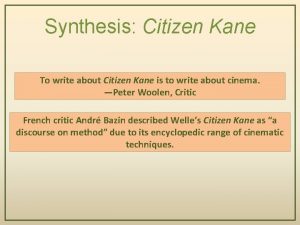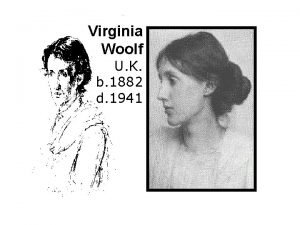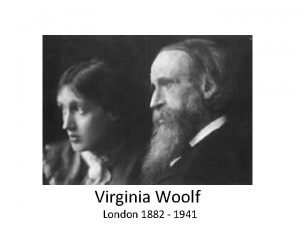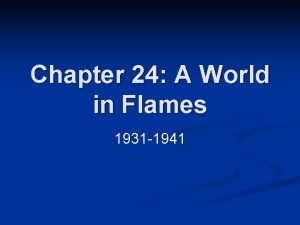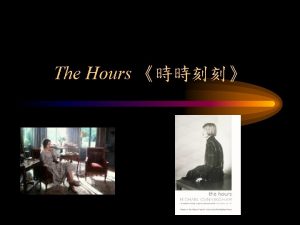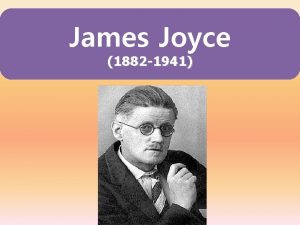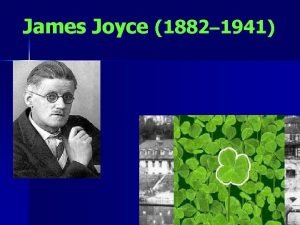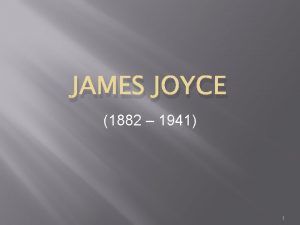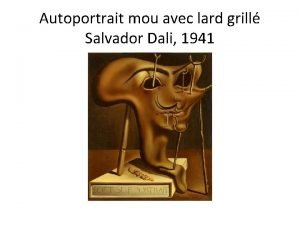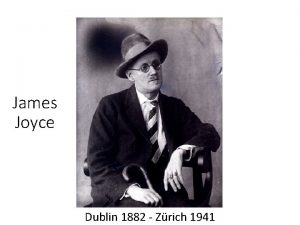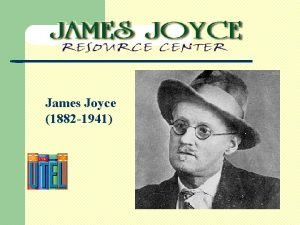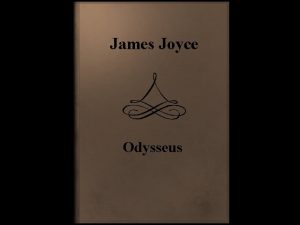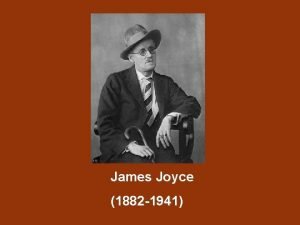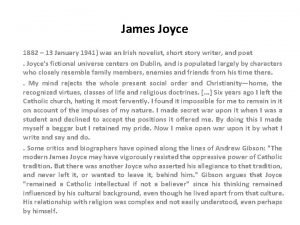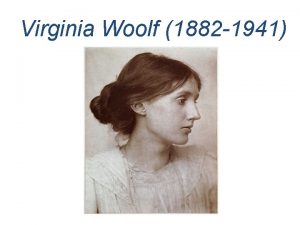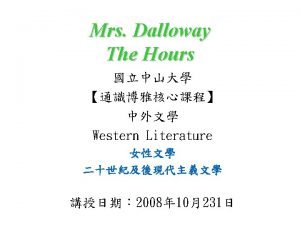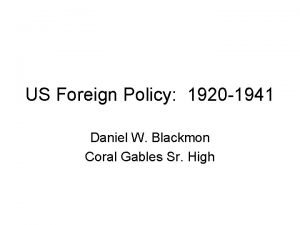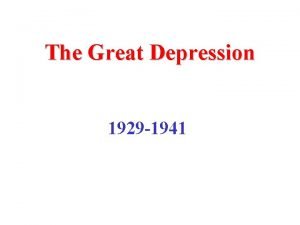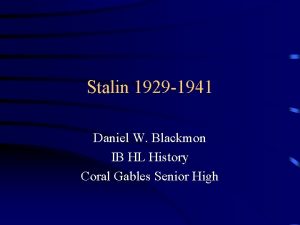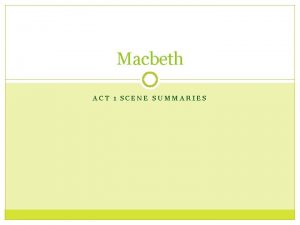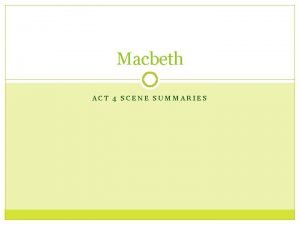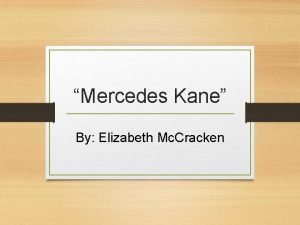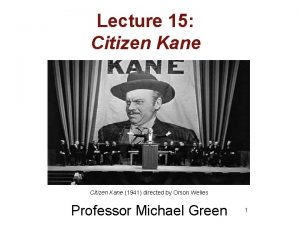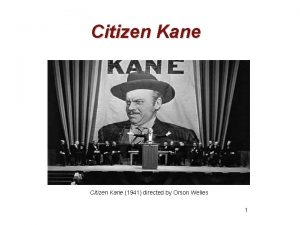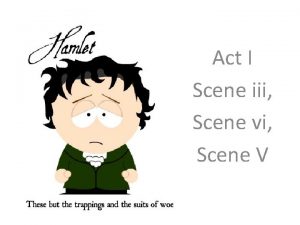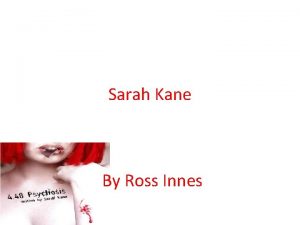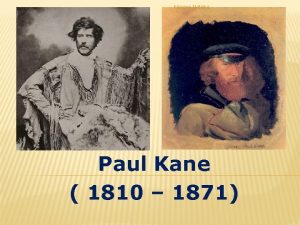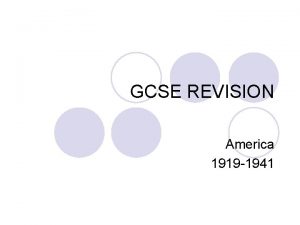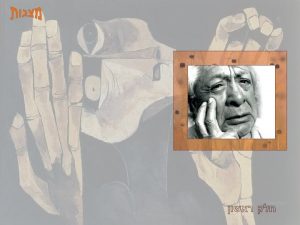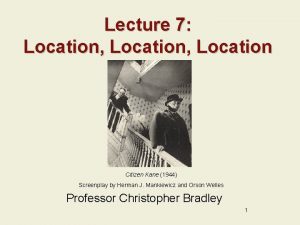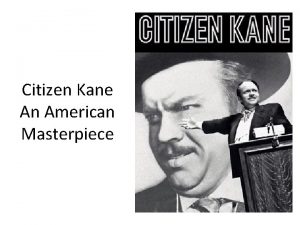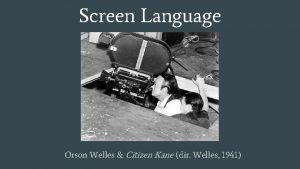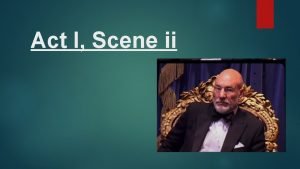Citizen Kane 1941 Scene Analysis In Citizen Kane







































- Slides: 39

Citizen Kane (1941) Scene Analysis

In Citizen Kane, Writer/Director Orson Welles, along with Cinematographer Gregg Toland changed the history of cinema. Although they didn’t invent deep focus lenses, expressionistic lighting and set design, or the techniques of recording overlapping dialogue, or the use of a non-linear story structure. They did put all of these elements together in a new way, in an intensified manner. The film is both a homage of technical innovation and storytelling from the silent era and something viewers hadn’t seen before. Citizen Kane continues to be on the ‘best ever’ lists over 70 years after it was released. Countless directors and cinematographers cite it as an influence.

• Depth of Field

Depth of Field Description One of the techniques that the movie is most famous for is “deep focus. ” As you can see in the image on the right, all of the characters—including the child in the window—are in focus. Toland achieved this through the use of a wide-angle lens to create a large depth-of-field. When this wasn’t possible, he would shoot the scene with the foreground fully lit and the background in darkness. Then, he would rewind the film and shoot the scene over again, with the background in focus and fully lit and the foreground in complete darkness. This is called an incamera matte shot.

• Depth of Field Depth of composition of a shot: several planes (vertical spaces in a frame): (1) a foreground, (2) a middle-ground, and (3) a background Depth of field specifically refers to the area, range of distance, or field (between the closest and farthest planes) in which the elements captured in a camera image appear in sharp or acceptable focus.

• Depth of Field Analysis: Extreme depth-of-field in shots in Citizen Kane heighten dramatic value and symbolic meaning. Dramatic Structure: mother, banker, father, boy outside are aligned along an axis, with the weakest being the boy. The framing of the boy by the window: he is trapped, and will be for the entire film. The actors are arranged so as to make cutting within the scene unnecessary. The characters are positioned so that they can’t look at each other directly, implying a theme of social alienation that is implied in the film. At this moment their eyes all point to the contract.

The Boarding House Scene:

Deep focus: Many Viewing Options The men around the table have just come over to the Inquirer in Kane’s takeover bid. They are a visual reminder of his money, his power, and even his ruthlessness.

Repetition in Film Language: The window (again) enriches mise-en-scene and adds a bit of visual irony: Bernstein and Leland discuss the ethical implications of Kane’s purchase of the "Enquirer" staff. Will the Enquirer staff start to change Kane or will Kane change them? We see both the men talking and at a distance we see Kane, in between them, framed in a window (as in the Boarding House scene). Thus repeating theme of Kane trapped by forces beyond his power. The image also suggests the triangular relationship of these 3 men.

The Largest Element in a Shot is NOT Always the Most Significant: The man in the background, Kane, the smallest one visually, holds the greatest power. As the shot unfolds, we watch him watch the voice teacher lose his patience with Susan. Kane then bullies him into overlooking her lack of talent and continuing on with the lesson. Visually, this shot is an unobtrusive way of revealing the power of Kane and his money.

One Image depicting both the Psychology of Character and the film’s narrative technique: The movie shows us Kane from many points of view. The implication is that he is a person of many different, even contradictory, sides--good and bad. Here is a way of visualizing that. After destroying Susan’s bedroom, Kane walks off. The mirror effect and the many Kane’s suggest a torn, fragmented, contradictory self.

This comes from the scene in which Kane first meets Susan. She has a toothache. He has just been splashed with mud from a passing carriage. She invites him up to her rooms. They talk. Then he asks her to sing for him. This shot stays on the screen for a slightly longer duration. We hear Susan struggling to sing (as always). Then, very slowly this dissolve takes place….

Susan’s voice continues throughout the scene as the first shot dissolves into this one. That sound is one way the two shots are linked. But why dissolve? What does this second shot tell us happened?


This is one of the subtlest touches of style in the film. The dissolve, of course, suggests time passing. The second shot shows us a different apartment--bigger, nicer, better furnished, costlier. The implication is that over time Kane has bought Susan this new, nicer apartment. It is clear that her singing has not improved, so what other means would she have of paying for it? If he is giving her a new apartment and nicer clothes, what is she giving him? Right. She is his mistress. The background (light over the bed) suggests this. In about 20 seconds of screen time, we have been shown the basic nature of their relationship.

Repetition and Parallelism: Breakfast Table sequence with Kane and his 1 st wife Emily Sitting Parlor room sequence with Kane and Susan What is the relationship between the two scenes?

• Deep Focus Like the boarding house scene, the placement of the actors indicate their psychological relationship. Charles Foster Kane looms bigger than life in the life of his friend, Jed Leland. Farther back in the frame, Bernstein will stand in the doorway behind Leland.

• Lighting (click on image for Projection Room Scene)

• Lighting was also an important aspect of Citizen Kane. In this shot, the strong backlighting is used to make the character in front appear as only a silhouette and therefore anonymous to the viewer. The smoke that fills the room helps to show the light beams coming from the projectors as well as the lamp on the table. The high-contrast lighting creates a foreboding atmosphere. The reporter stalks the meaning of George Foster Kane for the rest of the movie.

• Low-Angle Shots Another thing that made Citizen Kane stand out from other movies of its time was the way it used lowangle shots. The sound stages in Hollywood filmmaking made it impossible to show low-angle shots without revealing the microphones and lights that hung above the actors. To overcome this problem, Welles built whole sets with ceilings made of draped muslin, so the microphones were hidden above the cloth ceiling. Then, he cut holes in the set floor for the camera, so it could get the lowest angle possible. It made Kane in particular appear “larger than life. ”

• Low-Angle Shots This is how Welles and Toland filmed the scene in the newspaper office after the failed election.

Kane – low angle sequence (click on image).

• Low-Angle Shots It’s not just one element that makes up the meaning of a shot. The low angle and deep focus, combined with placement of the actors all contribute. Even Susan’s physical bearing says something (she’s finally standing up to Kane). The doll on the bed comments visually that Kane has viewed Susan as a possession. It puts the low ceiling in view, which presses down on them. The beam cuts in-between them.

• Editing Episodic Sequences - Passage of Time

• Editing Episodic Sequences Passage of Time One of the story-telling techniques introduced in this film was using an episodic sequence on the same set while the characters changed costume and make-up between cuts so that the scene following each cut would look as if it took place in the same location, but at a time long after the previous cut. In this way, Welles chronicled the breakdown of Kane's first marriage, which took years of story time, in a matter of minutes.

The Breakfast Sequence – A Marriage Dissolves: Click on Image.

• Psychological Spaces: The breakfast table is also an example of how the placement of actors within the frame is used to imply psychological dynamics between characters. Kane and his 1 st wife grow apart. The image here depicts Kane’s marriage to Susan by the time they go to live in the cavernous Xanadu. Click on image for film clip Of this scene.

• Dissolves

• Dissolves Opening Sequence: The “No Trespassing” sign is the first introduction to the dark life of Charles Foster Kane. We cut in towards one of Xanadu's windows; the room in which a light is shining. As the camera moves closer , the window stays in the same location in the frame. As we reach the window, the light vanishes, and we dissolve into a snowy blizzard. We see something that turns out to be a man’s lips, saying something. We hear words "Rosebud. ” The snow globe falls out of his hand.

• Citizen Kane Opening Sequence: click on image.

• Innovative Composition

• Citizen Kane Mirrors Scene: click on image.

Painting With Light Citizen Kane is an example of what the famous cinematographer John Alton called “Painting with Light. ”

• Sound In addition to expanding on the potential of sound as a creator of moods and emotions, Welles pioneered a new aural technique, known as the "lightningmix. " Welles used this technique to link complex montage sequences via a series of related sounds or phrases. In offering a continuous sound track, Welles was able to join what would otherwise be extremely rough cuts together into a smooth narrative. For example, the audience witnesses Kane grow from a child into a young man in just two shots. As Kane's guardian hands him his sled and wishes him a "Merry Christmas" we are suddenly taken to a shot of Kane fifteen years later, only to have the phrase completed for us: "and a Happy New Year. " In this case, the continuity of the soundtrack, not the image, is what makes for a seamless narrative structure.

Sound: Merry Christmas…. and a Happy New Year (15 years later).

• Sound Welles brought his experience with sound from radio along to filmmaking, producing a layered and complex soundtrack. In the “Jigsaw Puzzle” scene, note the cold echo in the room as Susan and Kane try unsuccessfully to communicate. The sound indicates how far apart the couple has become emotionally.

A wordless way of showing cause/effect: Susan has attempted suicide to get out of the embarrassment of her opera career. We see in the foreground the medicine she has used for her overdose. We see the drugged Susan in the middle ground. We hear Kane (the cause of the suicide attempt) banging on the door in the back.

Sound Welles also carried over techniques from radio not yet popular in the movies (though they would become staples). For instance: Using a number of voices, each saying a sentence or sometimes merely a fragment of a sentence, and splicing the dialogue together in quick succession. Using overlapping of dialogue, considering it more realistic than the stage and movie tradition of characters not stepping on each other's sentences. He also pioneered the technique of putting the audio ahead of the visual in scene transitions (an L-cut); as a scene would come to a close, the audio would transition to the next scene before the visual did.

The Screening Room scene has all of these elements:
 Citizen kane scene analysis
Citizen kane scene analysis Motifs in citizen kane
Motifs in citizen kane 1941-1882
1941-1882 1941-1882
1941-1882 Mulata com pássaro
Mulata com pássaro A world in flames, 1931–1941
A world in flames, 1931–1941 Suicide note virginia woolf
Suicide note virginia woolf 1978-1941
1978-1941 1941-1882
1941-1882 1941-1882
1941-1882 1941-1882
1941-1882 1882-1941
1882-1941 1941-1882
1941-1882 Salvador dali 1941
Salvador dali 1941 1941-1882
1941-1882 1941-1882
1941-1882 Stream of consciousness literature
Stream of consciousness literature Leopold bloom
Leopold bloom James joyce birthplace
James joyce birthplace 1941-1882
1941-1882 1941-1882
1941-1882 Tunneling technique woolf
Tunneling technique woolf Virginia woolf daughter
Virginia woolf daughter 1941
1941 1941
1941 Nicolas weissberg
Nicolas weissberg 1941
1941 Prosinec 1941
Prosinec 1941 Pada tahun 1941
Pada tahun 1941 Ho hum when he's finished pecking meaning
Ho hum when he's finished pecking meaning Arcadia conference 1941
Arcadia conference 1941 Macbeth act 1 and 2 summary
Macbeth act 1 and 2 summary Summary macbeth act 4
Summary macbeth act 4 Mercedes kane
Mercedes kane Charles l kane
Charles l kane Investments bodie kane marcus
Investments bodie kane marcus Kane ve kardeşleri slayt
Kane ve kardeşleri slayt Cern printers
Cern printers Investments bodie kane marcus summary
Investments bodie kane marcus summary Eli kane
Eli kane

